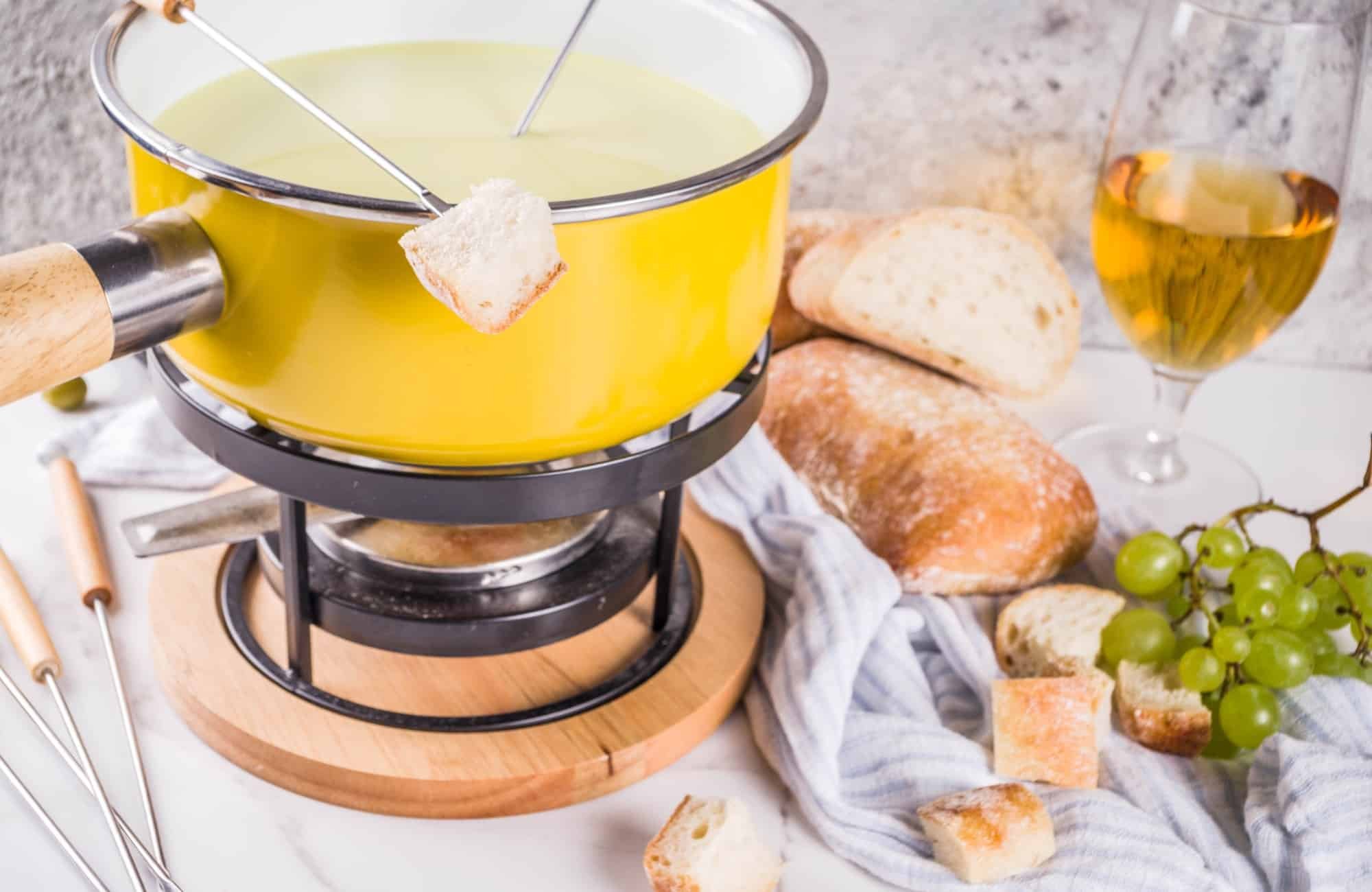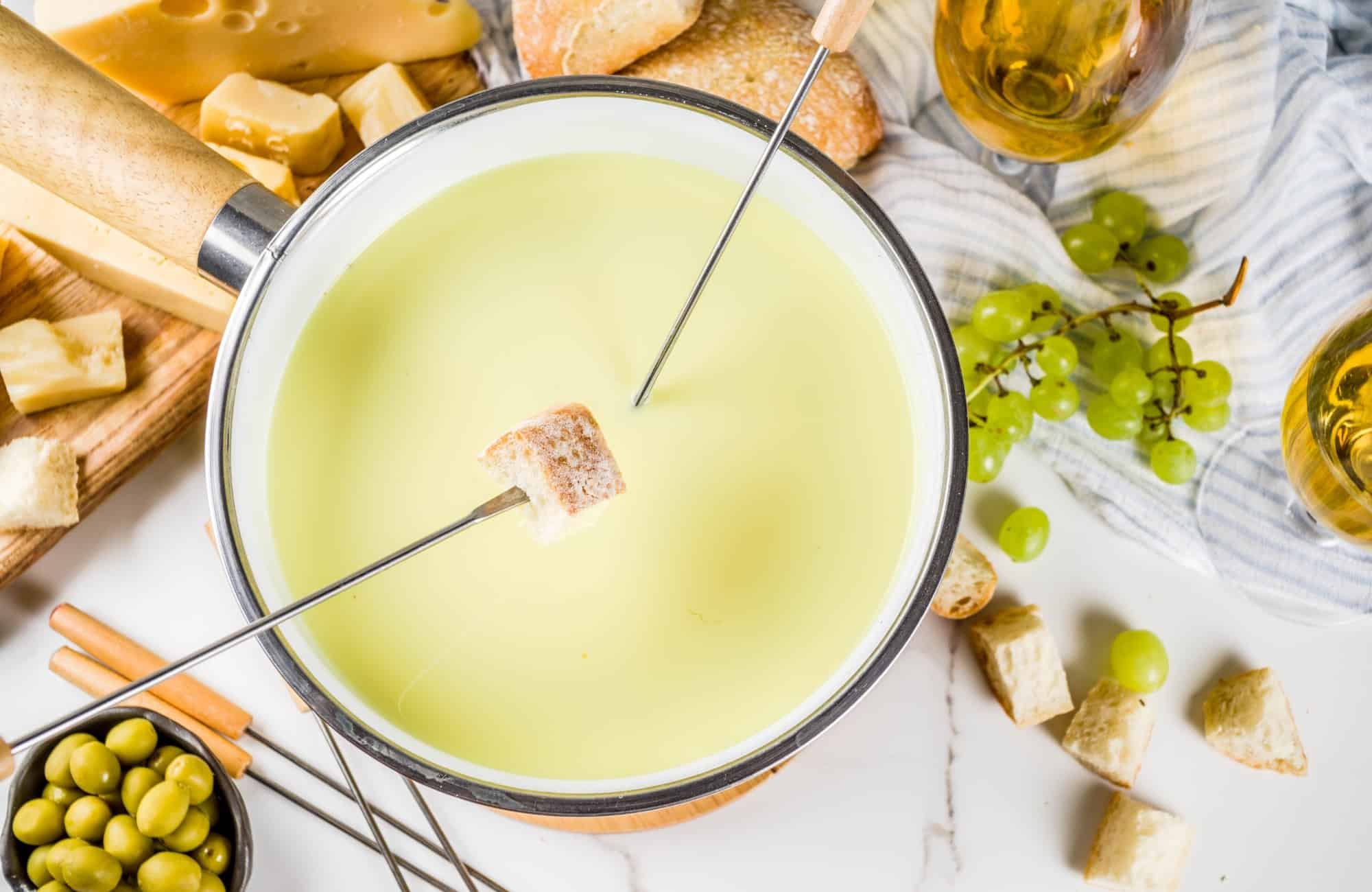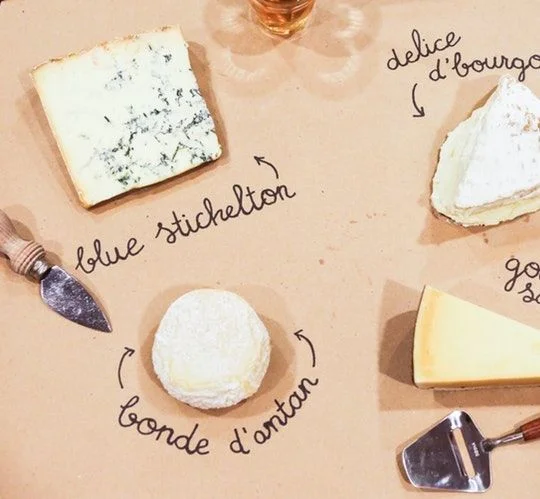It's Easy Being Cheesy With These Simple Fondue Party Ideas
I'm always looking for reasons to bring my crew together in the winter months-- especially between New Year's Eve and early springtime when my group of friends tend to hibernate and hunker down. So, I'm thrilled to share these fondue party ideas! Fondue parties are so much fun and the best way to celebrate winter: they're easy, charmingly retro, and most importantly, they're a great way to play with delicious and cozy food and drink options.
A fondue dinner party is one of my favorite ways to entertain because it's so easy! You're allowed to bypass a main course altogether and, instead, serve multiple rounds of different types of fondue. All you need is a heating element-- whether you're a fan of electric fondue pots or the old-school sterno variety is up to you-- and a set of fondue forks. Add some garlic cloves, melty cheese, cubes of crusty bread, apple slices, and par-cooked vegetables (brussels sprouts, red pepper, and cauliflower florets are personal faves), and that's a dinner party to die for!
No matter if you go for savory fondues, dessert fondue, or both (my personal preference)-- one of the most important things to establish with your guests is the rules of the game.
Have a cheesy night with these simple fondue party ideas.
Fondue Party Rules
Rule #1: If a woman drops her bread in the fondue pot, she has to kiss every man at the table.
Rule #2: If a man drops his bread in the fondue pot, he has to buy a bottle of wine for everyone at the table (this rule is clearly the best part of fondue dinner parties).
What's not to love about melted cheese, melted chocolate, tons of wine, and smooches galore? Sounds like my kind of evening. So invite some cuties, cue your Netflix Fireplace, and grab some delicious recipes for a fabulous fondue spread.
To Start: Cheese Fondue
Cheese fondue is a Swiss dish made with cheese, white wine, and garlic. It originated in the Valais region of Switzerland and has been enjoyed there since the 12th century. The traditional fondue recipe varies by region, but it's made with cow's milk cheeses like Emmentaler and Gruyère. There are so many variations on the classic you can serve, depending on your mood and your guests-- and since most of the joy comes in the dipping, it's fun to branch out beyond simply the obvious choice for your fondue skewer— cubes of bread— to more creative dippers. Here are some of my favorite cheese fondue recipes to try- just click the links below:
Traditional Swiss Fondue
Made with Raclette, Emmental, and Gruyere, this is gooey melted goodness. Made with white wine and a hint of garlic flavor in the classic tradition.
What to Dip: cubed French bread, pickled vegetables
Sauternes and Stilton Fondue
This sophisticated recipe combines a different cheese than what's typically used: Stilton, in a pungent English blue. Martha's recipe combines it with creme fraiche and Sauternes, a sweet white wine from Bordeaux, France.
What to Dip: hearty walnut bread, fingerling potatoes
Goat Cheese Fondue
If you're looking for something light, fresh, and tangy, this is the perfect variation. Combine buttermilk, fresh chives, thyme, tarragon, and parsley with goat cheese for a refreshing take on the classic.
What to Dip: blanched asparagus, zucchini, apple slices
For Meat Lovers: Hot-Pot Type Fondue
Suppose you want to cook proteins like seafood or raw meat. In that case, there are two ways to do that: an oil fondue (where you will heat hot oil to 375 degrees and allow your dippers to poach in the oil) or a broth fondue, a similar process with hot broth.
Broth Fondue
To make this, use chicken broth heated until boiling. Broth has a lower boiling point than oil, so the proteins and veggies will cook slower. But you can serve a green salad or an appetizer course while everyone's dippers are being cooked!
What to Dip: Meatballs, pork chop cut into bite-sized pieces, sausages, zucchini.
Oil Fondue
The best oil for this is canola oil- which has a neutral flavor and a higher smoke point than olive oil, which will burn. You can also use grape seed oil, peanut oil, or sunflower seed oil. Be sure to put only a few foods in the oil simultaneously, or the oil temperature will drop too dramatically.
What to Dip: lean cuts of beef like tenderloin, shrimp, scallops, onion slices, asparagus
A Sweet Finale: Chocolate Fondue
I can't think of a better way to end an evening than dipping sweet treats into a giant communal pot of gooey melted chocolate (or if you happen to have one, a chocolate fountain)! And the sky is the limit with fun goodies to dip. Try making a mini pot for two as a sexy Valentine's Day treat!
Milk Chocolate Fondue
This is the classic Swiss chocolate fondue recipe, creamy and luscious.
What to Dip: strawberries and fresh fruit, pound cake, marshmallows. I also love to make a platter of salty treats to dip, like potato chips, pretzels, ritz crackers, or even bacon!
Dark Chocolate Fondue
This is deeper and more sophisticated. I love to add a splash of liqueur, such as Grand Marnier, Chambord, Framboise, or even Frangelico.
What to Dip: dried fruit like apricots and pears, dark cherries, biscotti
White Chocolate Fondue
Add a splash of Champagne or Prosecco to make this one extra fun! This would be amazing for Galentine's Day.
What to Dip: fresh fruit like raspberries and peach slices, salty snacks like pretzels, cubes of frozen cheesecake
What to Drink At a Fondue Party
Take your gathering to the next level by offering some sommelier-approved wines, beers, and cocktails!
Kickoff Cocktail: Kirsch Punch
Some classic cheese Fondue recipes will feature a splash of Kirsch, a dry cherry brandy. I love this one from Trimbach. Why not mix the rest of the bottle into a festive cocktail?
Kirsch, also known as Kirschwasser, is a colorless spirit made from fermented, double-distilled sour morello cherries. Because morellos originate in the Black Forest of Germany, Kirsch is thought to have originated there. Still, it's also now made in Switzerland and Alsace, France. Kirsch is not sweet and tastes like bitter almonds. Traditionally served neat and chilled, it's fantastic in a festive punch.
Kirsch Punch Recipe:
1/2 cup Kirsch
1/2 cup white wine, such as Riesling or Sauvignon Blanc (you can go cheap on this, no one will be able to tell)
2 to 4 ounces of cherry-flavored seltzer
Dried cherries (or brandied cherries if you are fancy!) and lemon slices for garnish
Mix the Kirsch, wine, and cherry seltzer in a pitcher and pour into glasses over ice- garnish with cherries and lemon.
White Wine: Chardonnay from France’s Jura Region
To embrace the apres-ski theme, I'm recommending a white wine from the Jura wine region of France, like Domaine de Montbourgeau L'Etoile Chardonnay 2015, $23. The region is nestled into the Jura Mountains between Burgundy and Switzerland. This is a wildly interesting, slightly funky Chardonnay that even non-Chardonnay fans will enjoy trying. Its light natural acidity will refresh the palate between bites of decadent fondue.
The Jura is a tiny mountainous region known for its widely varied terroir of different types of limestone. It's most well-known for Chardonnay and Pinot Noir. However, they also grow Trousseau and Poulsard, along with a grape called Savagnin, to make Vin Jaune, a special oxidized wine that's a signature of the region.
The Romans cultivated the Jura region around 50 BC and brought their knowledge of winemaking methods. There's a ton of history regarding winemaking in the area, but it was first recognized as an Appellation d'Origine Contrôlée (AOC) in 1936.
Red Wine: Lagrein from Italy’s Alto Adige Region
Lagrein (la-GRINE) is a red grape grown primarily in Italy's Alto Adige- a region so far to the north in Alpine Italy that it practically touches Austria and Switzerland! Lagrein is fresh, aromatic, lightly spicy, slightly velvety, and truly seductive... full of forest berry fruit. Serve a bottle like Muri Gries Lagrein 2017, $19, lightly chilled!
Alto-Adige has been producing wine since the Roman Empire. The area is known for its unique grape varieties, including Lagrein, Merlot, Pinot Grigio, and Zweigelt. The region is also well known for its wines from the indigenous grape varietals: Schiava, Lagrein, and Teroldego. Most of Alto-Adige's vineyards are located near the town of Bolzano, which sits at an altitude of about 1,000 feet above sea level. The area benefits from its proximity to the mountain ranges that create some of Europe's best-known ski resorts. It also receives a lot of precipitation—a whopping 95 inches each year.
Beer: Belgian Farmhouse Saison Ale
The Farmhouse Saison category of beers will be perfect with fondue for your beer option. Try Ommegang Hennepin, ($8/750ml), which is bright and lively, and it's effervescent like Champagne- but it's brewed with ginger and other spices, so it's refreshing, yet warming.
This beer is made with a blend of spices similar to those used in traditional Belgian farmhouse brewing recipes. The result is an easy-drinking beer with a slightly tart flavor, crisp finish, and just a hint of citrus. Saison means "season" in French, and traditionally it was made in the winter but consumed in summer. Although Farmhouse Saison ales are brewed similarly (and for the same purpose), saisons tend to have a more distinct hop flavor, with bright, fruity aromas, a smack of tartness, and a crisp, dry finish. It will be a refreshing counterpoint to the fondue's richness.
After Dinner: Poire Williams Eau de Vie
No dinner party is complete without a nightcap!
The Swiss traditionally pass around a pear brandy called 'Poire Williams' as soon as the flame under the fondue pot is blown out. Poire Williams is an Eau de Vie, a European brandy category of dry fruit. Eau de Vie translates to 'water of life.' Although it's originally French, it's widely produced in Austria, Switzerland, Germany, and Northern Italy. Eau de Vie is distilled in a copper pot still-- the fruit will either be crushed and fermented before distillation, OR it will be soaked in a neutral grain alcohol (a process called maceration) to extract the fruit flavor before distilling. Eau de Vie is traditionally made from raspberries, yellow plums, apricots, cherries, apples, peaches, and in the case of Poire Williams, pears.
If you can score an authentic bottle of Poire Williams, it's a real showstopper at a party because there's an entire pear inside the bottle! Poire Williams producers attach the glass bottles to pear tree branches to achieve this, so the pears grow inside (Williams pears are also known as Bartlett pears). It can be hard to find in the US, but it's worth it for sheer dramatic effect! If you can't find one of these impressive bottles (they are extremely expensive), an easy sub is St. George Pear Brandy, $39.99.
This brandy should be served over chilled and poured into a cordial glass. A little goes a long way- about 2 oz. per person is enough. Eau de Vie is famous as a digestif- meant to help settle the stomach after a meal and aid digestion. Other well-known digestifs include amaro, sambuca, aquavit, and chartreuse.









